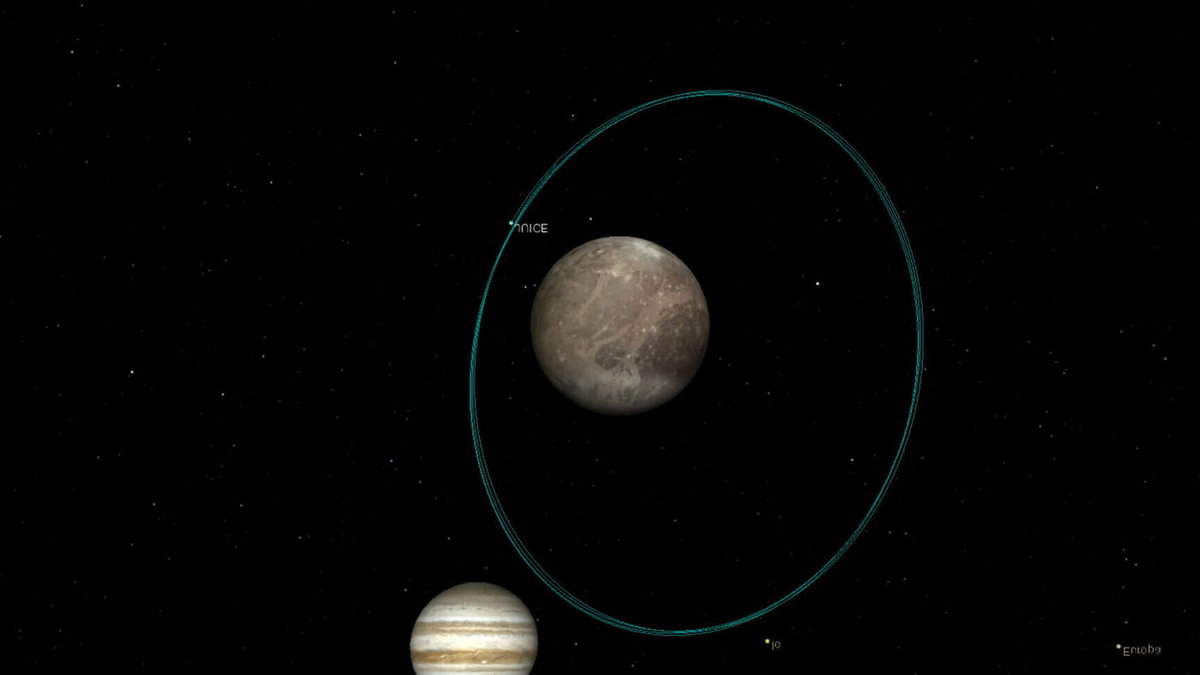Ganymede, the largest moon in the solar system, is a satellite of the planet Jupiter.
In 1610, Galileo Galilei made a remarkable observation when he spotted four bright spots near the massive planet Jupiter. Initially, he mistook them for stars, but he soon realized that they were actually satellites.
Among these satellites was Ganymede, which holds the distinction of being the largest moon in the solar system, even larger than the planet Mercury. It is also the only moon known to possess a magnetosphere, an atmosphere composed mainly of oxygen, and an internal ocean.

Discovery and designation
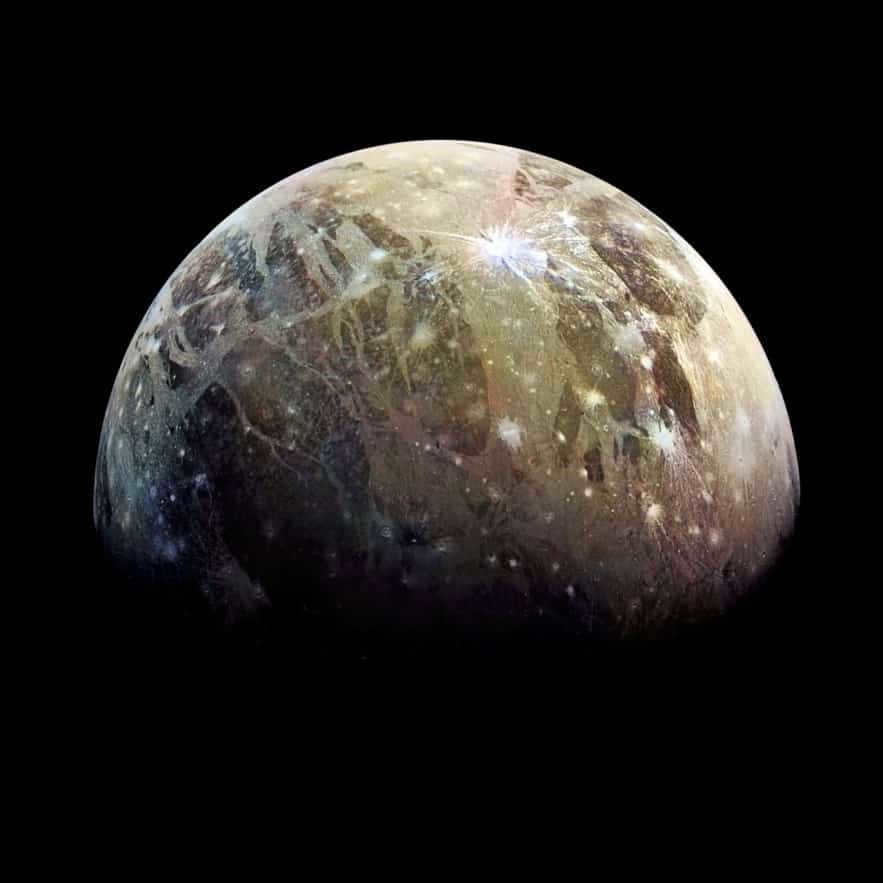
The observation of Ganymede can be traced back to Chinese records from 365 BC, where it is referred to as Gang De. However, the official discovery is credited to Galileo, who successfully pointed his instrument towards the sky on January 7, 1610.
Originally, the satellites were named using Roman numerals. However, Simon Marius, who claimed to have independently discovered the moons, proposed his own names, which are still in use today.
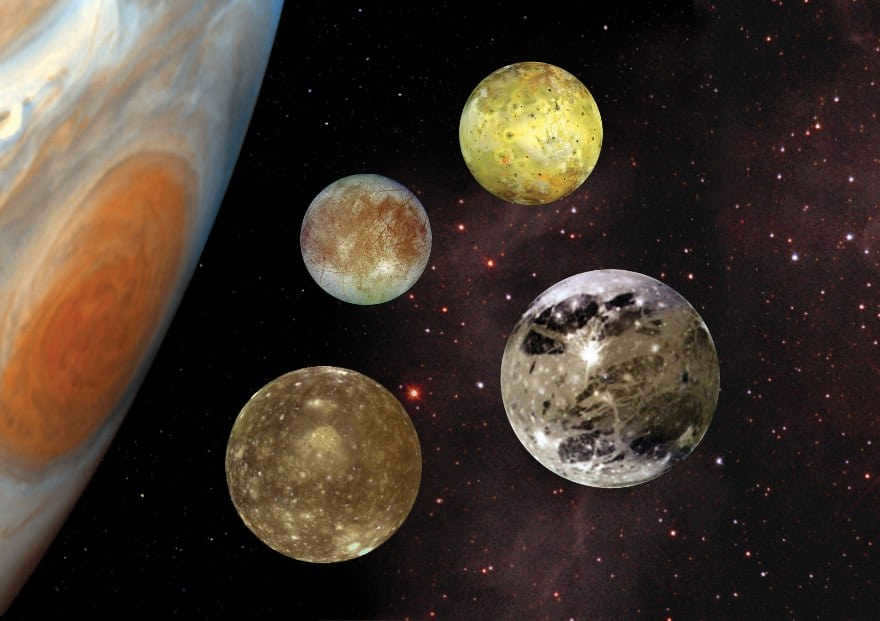

Jupiter and the satellites of Galileo
In ancient Greek mythology, Ganymede was born to King Tros.
A knowledgeable tarot reader will provide answers to the following inquiries:
What does the future hold for you? How will your relationships progress? Which decision is the best one to make?

Dimensions, weight, and orbit
Ganymede is the biggest moon in our solar system, with a radius of 2634 km (0.413 times the radius of Earth). However, its mass is 1.4619 x 10 23, indicating a composition of water ice and silicates.

These images illustrate the comparative sizes of various satellites and planets within our solar system.
Ganymede, one of Jupiter’s moons, has an eccentricity value of 0.0013 and its distance from Jupiter ranges from 1,069,200 km to 1,071,600 km, with an average distance of 1,070,400 km. It completes one orbit around Jupiter in approximately 7 days and 3 hours. Ganymede remains in a gravitational lock with Jupiter, meaning its orbit is stable and it is constantly influenced by Jupiter’s gravity.
Therefore, we can conclude that Ganymede is a satellite of the planet Jupiter.
The primary characteristics of Ganymede, the satellite
Ganymede’s orbit is inclined to the equator of the planet, resulting in orbital variations ranging from 0 to 0.33 degrees. The satellite is in a 4:1 resonance with Io and a 2:1 resonance with Europa.
Composition and Surface
The density of Ganymede, which is 1.936 g/cm^3, suggests that it consists of equal amounts of rock and ice. Water ice makes up around 46-50% of the moon’s mass (less than Callisto), and there is a possibility of ammonia formation. The surface has an albedo of 43%.
Infrared and UV surveys have revealed the presence of carbon dioxide, sulfur dioxide, as well as cyanogen, hydrosulfate, and various organic compounds. Subsequent studies have discovered sodium sulfate and magnesium sulfate, which might have originated from the subsurface ocean.
A knowledgeable tarot reader will address your inquiries.
What lies ahead in your future? How will the dynamics of the relationship play out? What is the optimal choice to make?

The planet Ganymede, which is a satellite of Jupiter, has an internal structure consisting of a core, a mantle, and an ice shell. The core is composed of iron, with a liquid iron layer and a sulfide outer layer. It is estimated to have a radius of 500 km and is subjected to temperatures ranging from 1500 to 1700 K, with a pressure of 10 Pa.
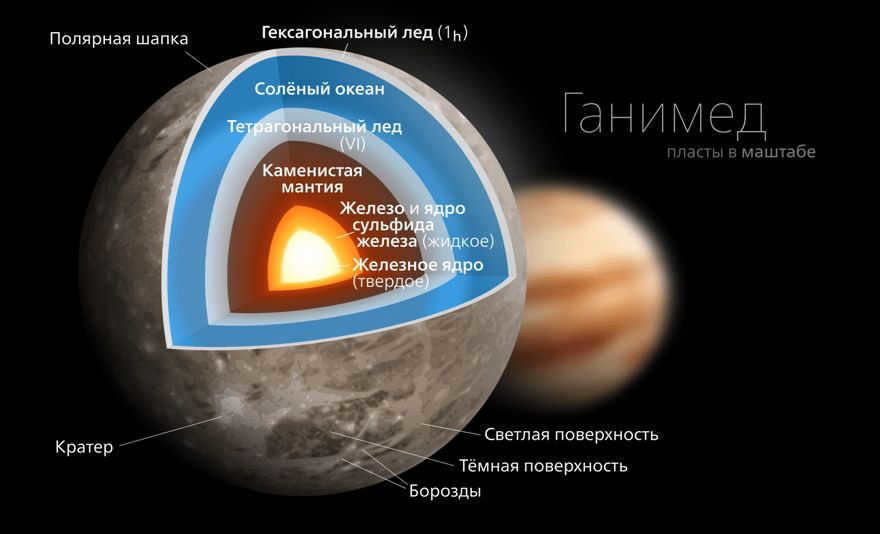
The internal composition of Ganymede
The moon’s magnetic field suggests the existence of a liquid iron and nickel core, most likely due to convection in highly conductive liquid iron. The core has a density index of 5.5-6 g/cm3, while the silicate mantle has a density index of 3.4-3.6 g/cm3.
The mantle consists of chondrites and iron. The outer layer is composed of ice and is the largest layer, spanning 800 km. It is speculated that there may be a liquid ocean between the layers, possibly indicated by the presence of auroras.
The surface of Ganymede exhibits two distinct types of terrain. There are ancient, dark, crater-like areas, as well as younger, light-colored areas with ridges and grooves.
The dark region covers approximately one-third of the total surface area and obtains its distinctive coloring from the presence of clay and organic substances within the ice. This unique feature is thought to be the result of crater formations.
The undulating landscape displays tectonic characteristics, which are attributed to cryovolcanism and tidal heating. The deformation may have generated elevated temperatures within the area, causing compression on the lithosphere and resulting in the development of faults and fractures that have affected about 70% of the dark region.
While the majority of craters are concentrated within the dark areas, they can also be found throughout the entire surface. It is believed that Ganymede experienced a period of intense asteroid bombardment approximately 3.5-4 billion years ago. Due to the weak ice crust, the impact craters appear more flattened.
Voyager observations have revealed the presence of ice caps on Ganymede. Data obtained from the Galileo spacecraft further supported the hypothesis that these ice caps were likely formed through plasma bombardment.
Atmosphere
Ganymede boasts a feeble oxygen-rich atmosphere, which arises from the existence of water ice on its surface. When this ice is exposed to ultraviolet light, it splits into hydrogen and oxygen.
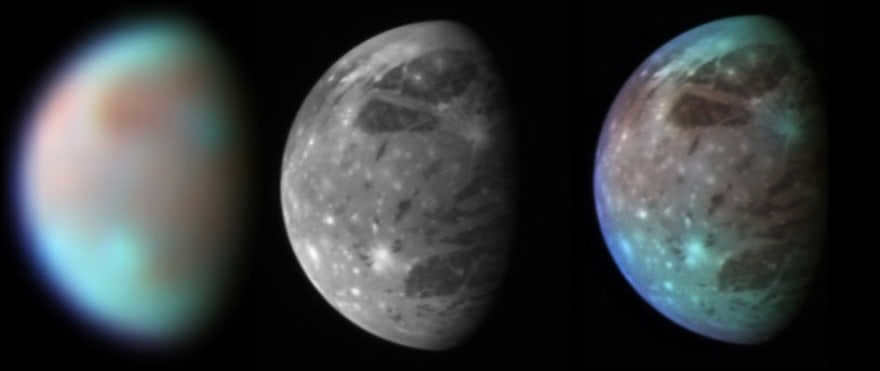
Observation of the New Horizons mission was conducted using the Infrared Spectrometer, LORRI and LEISA.
The existence of an atmosphere causes an airbrush effect, which is the emission of weak light produced by atomic oxygen and energetic particles. This lack of uniformity results in the formation of bright spots in the polar regions.
The spectrograph detected the presence of ozone and oxygen. This suggests the presence of an ionosphere, as oxygen molecules become ionized when struck by electrons. However, this has yet to be confirmed.
Magnetosphere
Ganymede possesses an exceptional feature – its own magnetosphere. The stable magnetic moment of Ganymede measures at 1.3 x 10 3 T – m 3, which is three times higher than that of Mercury. Additionally, the magnetic dipole of Ganymede is positioned at a 176° angle in relation to the magnetic moment of the planet.
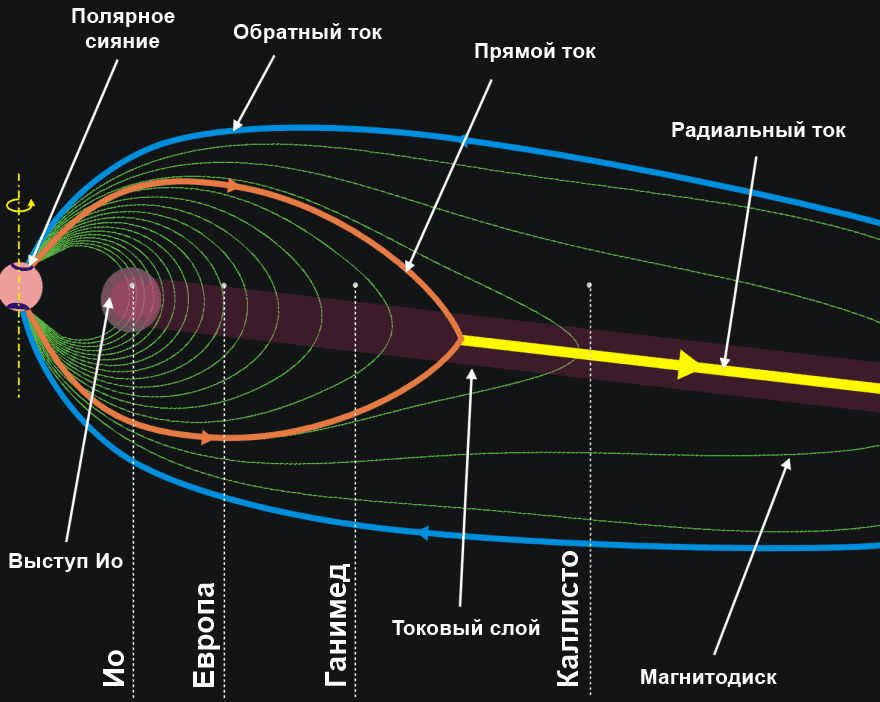
Jupiter’s magnetic field and the overall rotation of its currents are topics of interest. The strength of the magnetic field is measured at an impressive 719 Tesla, and the magnetosphere itself has a diameter ranging from 10,525 to 13,156 km. It is worth noting that closed field lines can be found below the 30° latitude mark, where charged particles are captured and ultimately contribute to the formation of a radiation belt. Among the various ions present, single ionized oxygen appears to be the most prevalent.
If you’re seeking insight into your future, the dynamics of your relationships, or the optimal solution to a problem, a seasoned tarotologist is here to provide answers.

The interaction between the magnetosphere of the moon and the plasma surrounding the planet is similar to the interaction between the solar wind and the magnetosphere of Earth. The presence of an underground ocean is suggested by the presence of an induced magnetic field.
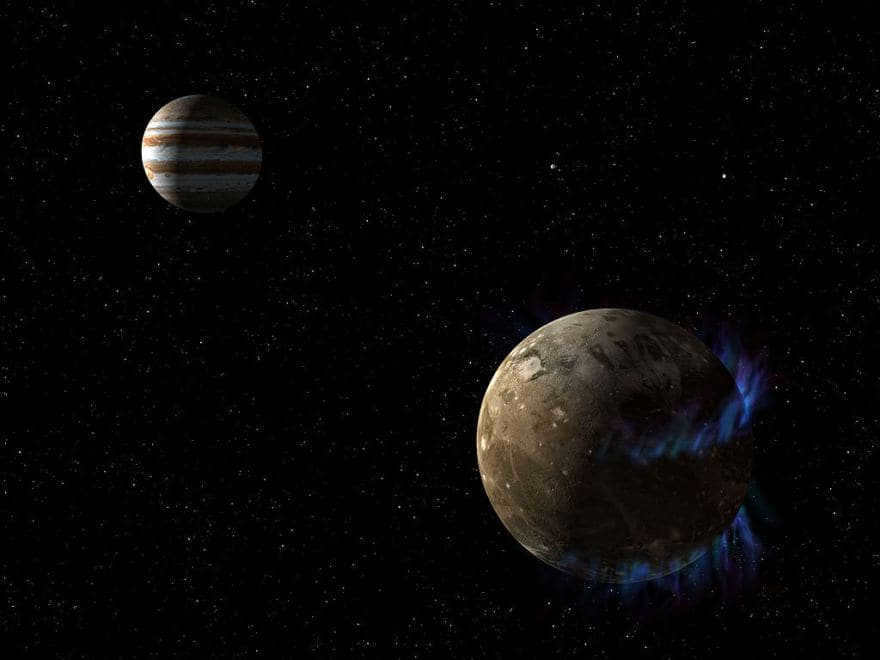
An artistic representation of the aurora phenomenon occurring on Ganymede
However, the origin of a magnetosphere on Ganymede remains an enigma. It is thought to be generated by a dynamo effect caused by the movement of material in its core. However, there are other celestial bodies with dynamos that do not possess magnetospheres. It is hypothesized that orbital resonances could provide an explanation. It is possible that increased tidal heating helps insulate the core, preventing it from cooling. Alternatively, the residual magnetization of the silicate rocks could be responsible.
Habitability
Ganymede, one of Jupiter’s moons, is an appealing candidate for the exploration of extraterrestrial life due to its potential subsurface ocean. Studies conducted in 2014 have indicated the existence of multiple layers of water beneath the icy crust, with the lowermost layer in direct contact with the rocky mantle.
This is particularly significant as the water could potentially receive heat from tidal flexing, creating favorable conditions for the existence of life forms. Additionally, the presence of oxygen further enhances the likelihood of habitability.
Multiple missions were dispatched to Jupiter, and they also observed characteristics of Ganymede. Pioneer-10 (1973) and Pioneer-11 (1974) were the initial spacecraft to pass by the moon. They furnished information about its physical attributes. Subsequently, Voyagers 1 and 2 arrived in 1979. In 1995, Galileo entered its orbit and examined the moon from 1996-2000. It managed to identify the magnetic field, the internal ocean, and acquired numerous spectral images.
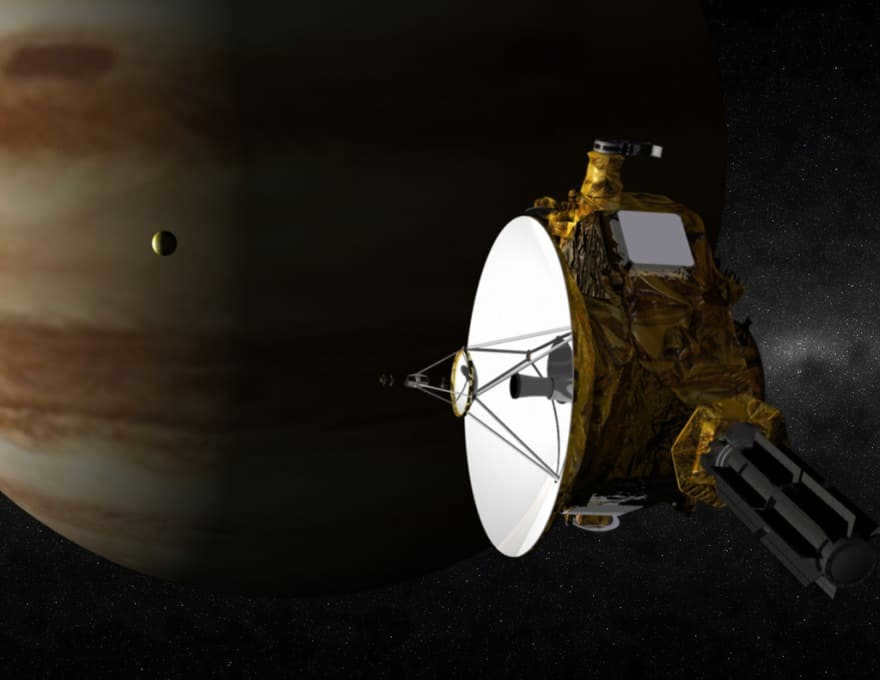
New Horizons’ flyby of the planet Jupiter
The latest examination occurred in 2007 during the New Horizons’ flyby of the dwarf planet Pluto. During this mission, the spacecraft generated detailed maps depicting the topography and composition of Europa and Ganymede, two of Jupiter’s moons.
Currently, there are multiple projects awaiting approval. One such project is JUICE, which aims to explore all of Jupiter’s Galilean moons. If approved, the mission could launch between 2022 and 2024.
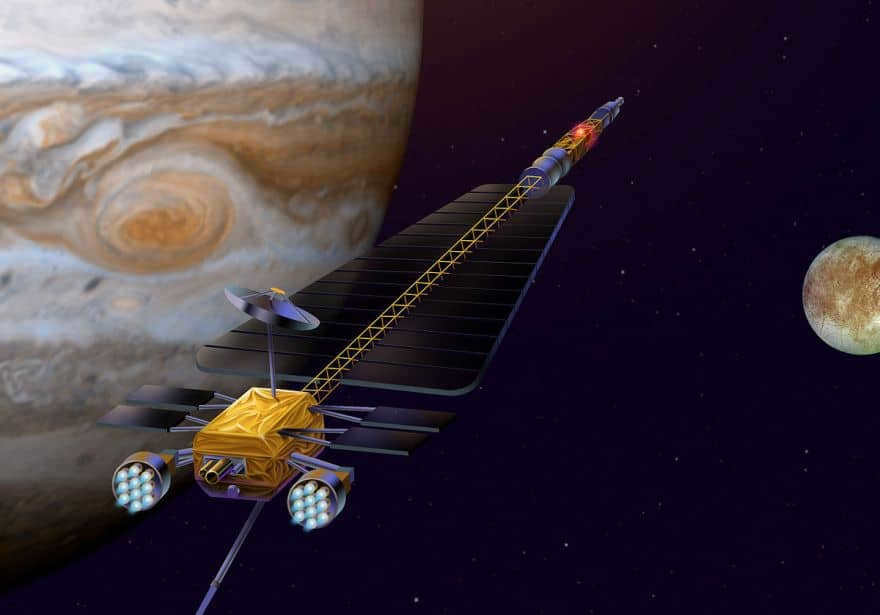
The JIMO program, which had planned to explore Callisto, Ganymede, and Europa, has been canceled due to insufficient funding.
One of the canceled projects was JIMO, which aimed to conduct a thorough investigation of the largest moon in the system.
Establishing a Colony on Ganymede
Ganymede presents an exceptional opportunity for the establishment and transformation of a colony. With its substantial size and a gravity of 1.428 m/s 2 (comparable to that of the Moon), Ganymede offers the advantage of requiring less fuel for rocket launches.
In addition, the presence of a magnetosphere provides protection against cosmic rays, while the abundance of water ice enables the production of oxygen, water, and rocket fuel. However, it is important to note that Ganymede’s magnetosphere is not as dense as what we are accustomed to, rendering it incapable of shielding against Jupiter’s radiation.
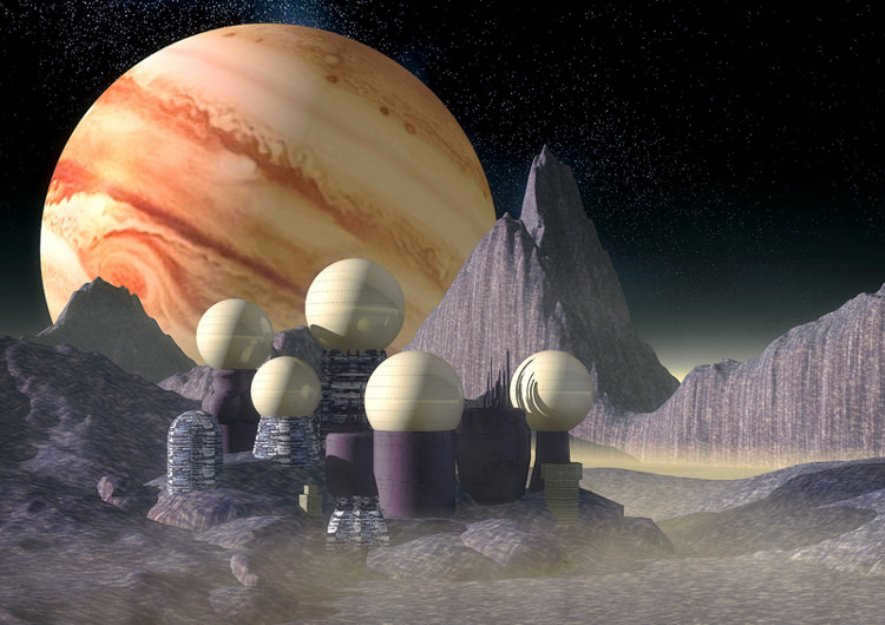
An artistic representation of the future colony on Ganymede
In addition, the magnetosphere alone will not be sufficient to maintain a dense atmosphere and comfortable temperatures. One potential solution is to create an underground settlement, closer to the ice deposits, where we would be protected from radiation and extreme cold. Currently, these ideas are still in the early stages of development. However, Ganymede is a celestial body that deserves careful consideration, as it has the potential to become either a source of life or a second home. The map will provide further details about the surface of Ganymede.
Map of the surface
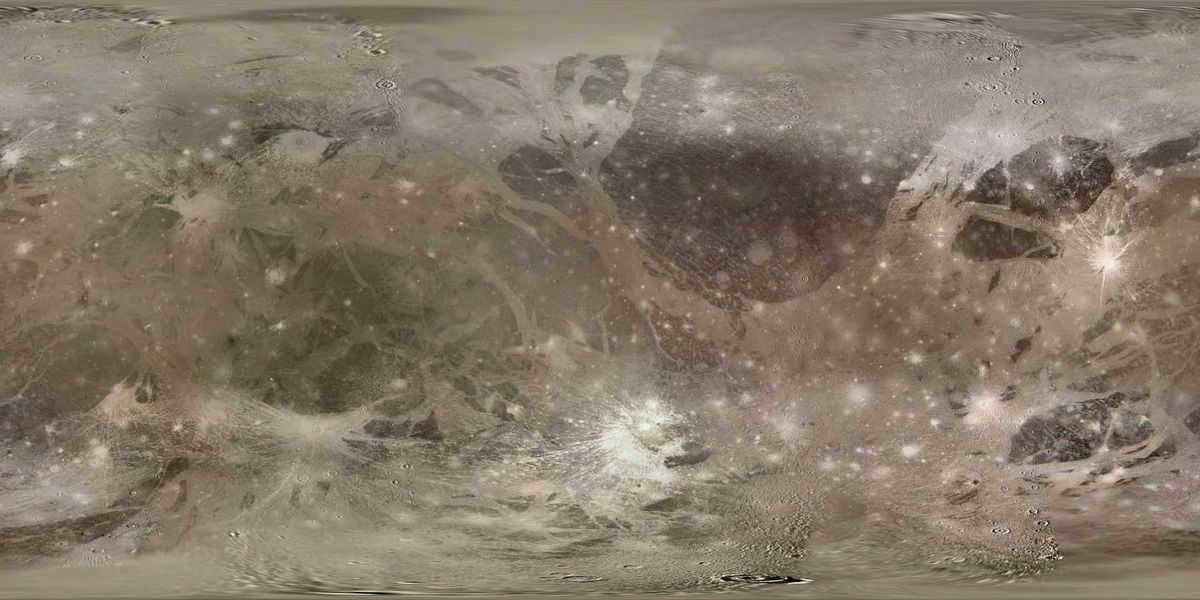

Feel free to click on the picture to view it in a larger size
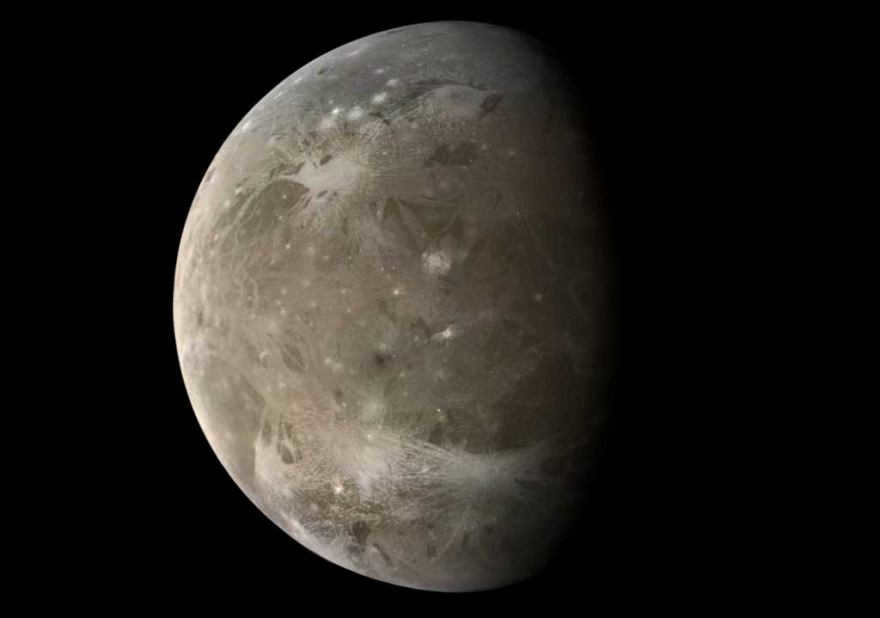
Ganymede is the largest moon in the entire solar system. It is even bigger than Pluto and Mercury, and slightly smaller than Mars. Children might find it fascinating to learn that if Ganymede orbited a star instead of Jupiter, it could be considered a planet. Parents or teachers can share this interesting fact with students at school.
Interesting Information about Ganymede – Explained for Kids
- Age: Ganymede is approximately 4.5 billion years old, which is the same age as Jupiter.
- Distance: Ganymede is the seventh moon of Jupiter and the third moon in the Galilean group. It is located about 1,070 kilometers away from the planet and takes approximately 7 days to complete one orbit around Jupiter.
- Size: Ganymede has an average radius of 2631.2 kilometers, making it larger than Mercury. However, despite its size, Ganymede only has about half the mass of Mercury due to its low density.
- Temperature: Ganymede experiences extreme temperatures. During the day, the temperature can reach as low as -171 degrees Celsius, while at night it can drop even further to -193 degrees Celsius. In 1996, scientists using the Hubble Space Telescope discovered traces of a thin oxygen atmosphere on Ganymede, but it is not sufficient to support life.
- Magnetosphere: Children should keep in mind that Ganymede is the unique moon with its own magnetosphere. Normally, this region is found around comets, where charged particles are captured and deflected. However, Ganymede’s magnetosphere is completely embedded within Jupiter’s magnetosphere.
Discovery and exploration – explanation for children
On January 7, 1610, Ganymede was discovered by Galileo Galilei. This was a significant finding that helped people realize that Earth was not the center of the universe. Initially, Galileo named the moon Jupiter III, but in the mid-1800s, it was renamed after the Trojan prince from ancient Greek mythology. According to the legends, Zeus transformed Ganymede into an eagle and brought him to Olympus, where he became the cupbearer to the gods.
For young children, it is crucial to understand that multiple spacecraft have traveled beyond the Earth’s atmosphere. The initial mission was carried out by Pioneer-10 in 1973, followed by Pioneer-11. Remarkable images were captured during the voyages of Voyager 1 and 2. The Galileo probe ventured 261 kilometers closer and captured intricate photographs.
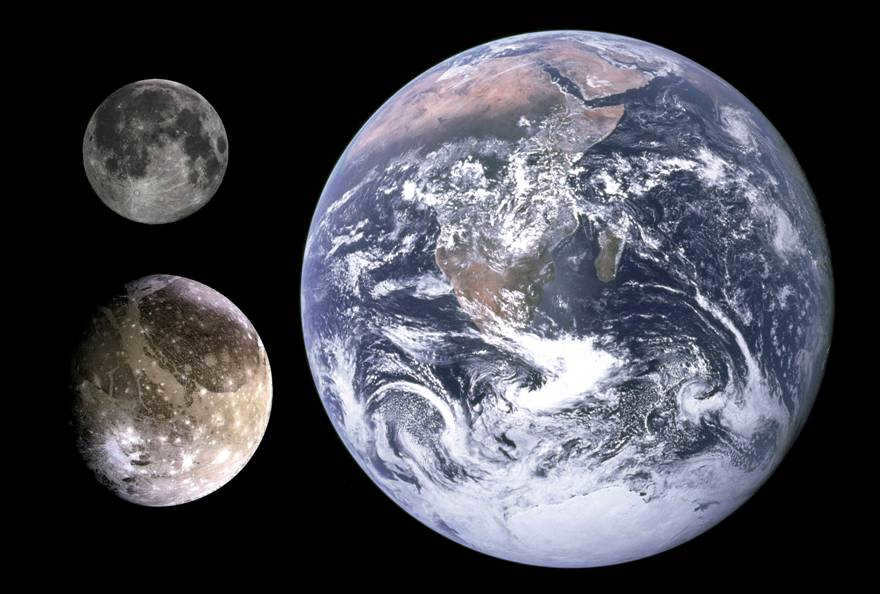
Comparative sizes of Ganymede, Earth and the Moon
The European Space Agency has plans to launch the JUICE mission to Jupiter in 2022, which will also include a study of Ganymede, Callisto, and Europa. Ganymede will be the primary focus of the mission, as this icy moon holds the potential to provide samples that may contain signs of life. Scientists will conduct a thorough examination of Ganymede’s atmosphere and composition in order to gather as much information as possible.
Understanding Ganymede – Explained to Kids
When we talk about Ganymede, it’s important to know what it’s made of. The inside of Ganymede has a core made of metallic iron. On top of the core, there is a layer of rock. And finally, the outermost layer is a really thick icy crust. If you look closely at the surface, you might notice some raised areas. These could possibly be rock formations!
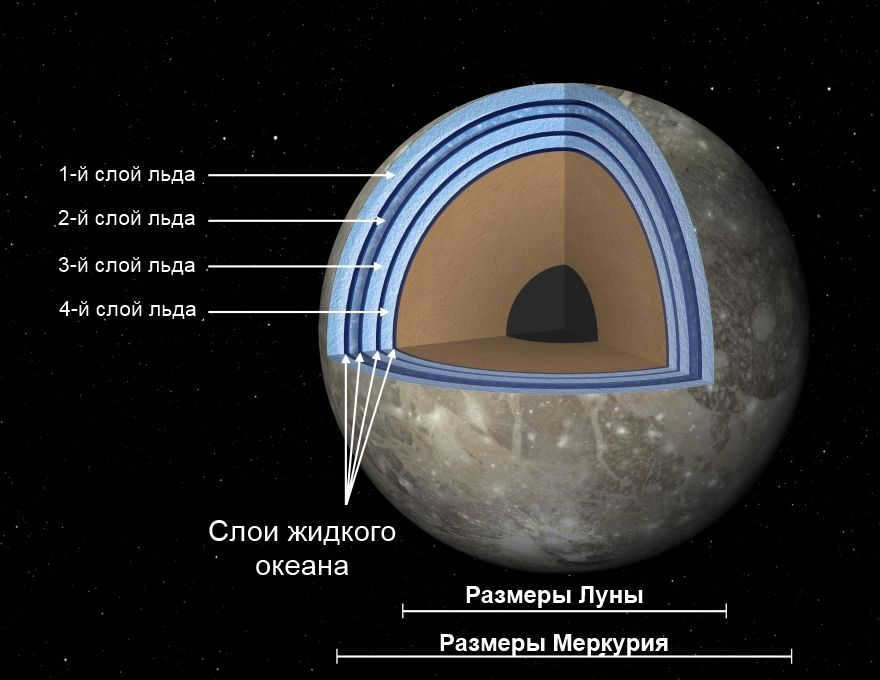
The internal structure of Ganymede
In February 2014, NASA and the U.S. Geological Survey produced the initial comprehensive map of the moon using images and video animation. This map was created based on data collected by Voyager 1 and 2, as well as the Galileo spacecraft. It is important to note that Ganymede’s surface consists of two distinct types of terrain: 40% of the surface is covered in dark areas with numerous craters, while the remaining 60% is characterized by lighter regions with gaps. These patterns may have been formed as a result of tectonic activity or the presence of subsurface water. These features extend for a distance of approximately 1,000 miles.
There is skepticism among certain researchers regarding the possibility of life existing on Jupiter’s moon Ganymede. They argue that the immense pressure at the moon’s oceanic base would cause it to freeze, preventing the delivery of essential nutrients to support extraterrestrial life.
We trust that the information provided about Ganymede, Jupiter’s largest moon, has been informative. When explaining this topic to children, it is recommended to utilize engaging elements such as fascinating facts, captivating photos, intriguing videos, and imaginative drawings in order to convey the information as clearly as possible. Additionally, our 3D model of the solar system, which includes a detailed map of Jupiter, surface features, and major satellites, is sure to captivate children of all ages. Interestingly, there are claims that Ganymede can be observed in real-time through an online telescope.
For further knowledge on Jupiter’s satellites, please explore the following resources:
When considering planets, individuals typically imagine enormous rocky worlds. However, there also exist gas giants that primarily consist of hydrogen and helium. These gas giants differ in appearance from regular rocky planets, except for the presence of a small rocky core. “Hitech” provides insight into the most renowned gas planets and examines the possibility of life existing on them.
Explore "Hytek" on
The term "gas giant" was initially utilized in 1952 by writer James Blish in a science fiction piece. At that point, no planets – whether gas or terrestrial – had been detected beyond our own solar system. However, we were already aware of our neighboring planets.
Jupiter – the largest planet in our solar system – boasts a radius nearly 11 times that of Earth. Comprising mostly of hydrogen and helium, the planet encloses a dense core made of rock and ice. Its voluminous composition is primarily liquid metallic hydrogen, which generates a potent magnetic field. Jupiter is observable with the naked eye and possesses numerous satellites. Its atmosphere is predominantly composed of hydrogen, helium, ammonia, and methane.
Saturn is known for its large rings and is approximately nine times the size of Earth. The origins of these rings are still a mystery. Saturn has been found to have several dozen confirmed satellites. Similar to Jupiter, Saturn is primarily composed of hydrogen and helium, with a dense core at its center. The atmosphere of Saturn is also similar to that of Jupiter.
Uranus is often referred to as the most peculiar planet in our solar system and has a radius roughly four times that of Earth. It was the first gas giant to be discovered using a telescope, as Jupiter and Saturn were visible to the naked eye in ancient times. Uranus is the only planet in our solar system that is tilted on its side. It has numerous satellites and its atmosphere consists of hydrogen, helium, and methane.
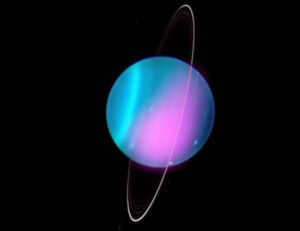
Neptune shares similarities with Uranus in terms of size, as it has a radius that is four times that of Earth. Just like Uranus, the planet’s atmosphere is primarily composed of hydrogen, helium, and methane. With over a dozen confirmed satellites, Neptune is known for its extremely fast wind speeds. Scientists also have aspirations to plan a mission to explore Uranus and Neptune within the next few decades.
A World Filled with Jupiters
Throughout the course of human history, our understanding of planetary formation and evolution has largely been centered around the eight (or nine) celestial bodies within our own solar system. However, in the past 25 years, the revelation of over 4,000 exoplanets, or planets that exist outside our solar system, has completely revolutionized our perspective.
These exoplanets, particularly the gas giants that reside closer to their host stars than even Saturn or Earth, have earned the moniker “hot Jupiters”. They hold a special fascination for scientists due to their incredibly close proximity to their stars, resulting in surface temperatures that soar well into the thousands of degrees Celsius.
Furthermore, a recent discovery by scientists unveiled the existence of NGTS-15b, a planet that bears a striking resemblance in size to Jupiter within our solar system. However, what sets this celestial body apart is its reduced mass, which is approximately 25% lighter. Notably, NGTS-15b follows an unusually close orbit around its host star, resulting in an effective temperature of 5,600 Kelvin (equivalent to 5,327 °C). This extraordinary planet is situated approximately 2,600 light years distant from our home planet Earth.
How were gas giants formed?
Astronomers hypothesize that gas giants initially originated as rocky and icy planets. However, due to the significant size of their nuclei, particularly Jupiter and Saturn, they were able to attract and capture hydrogen and helium from the surrounding gas cloud during the Sun’s formation. Subsequently, the Sun formed and took most of the gas with it.
In contrast, Uranus and Neptune, being smaller in size and having larger orbits, faced more challenges in efficiently accumulating hydrogen and helium compared to Jupiter and Saturn. This likely accounts for their smaller size. In terms of composition, their atmospheres are proportionally more enriched with diverse chemical compounds like methane and ammonia, hence being more “polluted”.
Is there any existence beyond our planet?
It is highly improbable for gas giants to harbor life forms similar to those we are familiar with. These extraordinary planets consist mainly of volatile substances and lack a solid surface, making it even more unlikely to discover life on luminous exoplanets. However, there is a potential chance to detect microbial life on different icy moons orbiting gas giants within our own solar system. This is the primary reason why scientists are actively engaged in studying these celestial bodies.
Recently, a complete network of seismometers was deployed in Antarctica. The objective is to test the functionality of these devices on the icy moons within our solar system. Additionally, the European Space Agency has planned to launch the Jupiter Icy Moons Explorer (JUICE) mission in 2022. This mission will investigate Jupiter’s three satellites – Ganymede, Callisto, and Europa – in order to assess the potential for life. Furthermore, the Europa Clipper probe has recently been launched to search for extraterrestrial life on Jupiter’s moon, Europa, which is currently considered a top contender for hosting life.
For further information, click here
Ganymede, one of Jupiter’s seemingly ordinary moons, is actually an exceptional celestial body within our solar system. Not only is it larger than some planets, but it also holds the possibility of hosting life. “Hitech” presents the most captivating facts about this gas giant’s satellite.
Check out “Hitech” on.
In December 2021, the lead researcher of the Juno project shared a brief 50-second audio recording captured by NASA’s spacecraft during its pass by Ganymede.
Interestingly, Ganymede is the fourth largest entity in the solar system in terms of size (following Earth, Venus, and Mars). Importantly, the moon’s mass is twice that of Earth’s Moon.
It was discovered in the 17th century
Ganymede, one of Jupiter’s four satellites, was discovered in the 17th century by the Italian astronomer Galileo Galilei. Initially, Galileo mistook them for stars, but upon further observation, he noticed that these “stars” were in fact orbiting Jupiter. It wasn’t until a few days later that Galileo realized they were moons and named them “Medici Stars” after the Duke of Tuscany.
Later, another scientist suggested naming them after Zeus’ favorites from Greek mythology. Eventually, they became known as Io, Europa, Ganymede, and Callisto.
The exclusive satellite equipped with a magnetosphere
Not every celestial body possesses a magnetosphere – only Earth, Mercury, Saturn, Mercury, and Jupiter are known to have this feature. Interestingly, this phenomenon has not been observed on any moons until 1996, when NASA’s Galileo spacecraft detected distinctive whistling and static sounds emanating from a particular satellite. This groundbreaking discovery led scientists to believe that Ganymede possesses a magnetosphere that is self-generated.
This revelation strongly suggests that Ganymede harbors an active inner liquid core, most likely composed of iron and nickel, situated at a depth ranging from 400 to 1,300 kilometers. The convection of liquid iron, which exhibits high electrical conductivity, is responsible for the creation of the magnetic field.
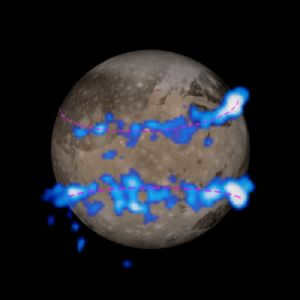
The auroral belts on Ganymede were initially observed in ultraviolet images and later confirmed by the plasma wave spectrometer on the Galileo spacecraft and the spectrograph on the Hubble telescope.
Quite a substantial amount of water
Ganymede consists primarily of silicate rock and water ice. The rocky material is layered above a metallic iron core and is distributed in various clusters beneath the icy shell. There is a strong belief that liquid water exists beneath the surface, which is known to be salty and rich in magnesium sulfate.
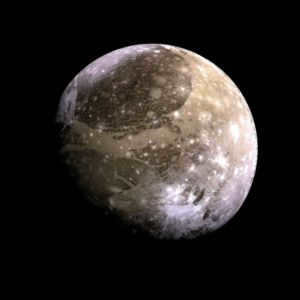
The European Space Agency (ESA) plans to send the JUPITER Icy Moon Explorer (JUICE) probe to Ganymede, as well as Jupiter’s other two moons, Europa and Callisto, in order to investigate the potential habitability of Ganymede. The probe is scheduled to be launched sometime between August and September 2022 and is expected to enter Ganymede’s orbit around 2032. It is possible that during the mission, scientists may discover resilient forms of life on Jupiter’s moon.
For more information, click here
Ganymede is the largest moon in the solar system and one of Galileo’s four moons. It was discovered by Galileo in 1610 and orbits Jupiter along with Io, Europa, and Calisto.
Advertisement
can be paraphrased as
Commercial
or
Promotion
.
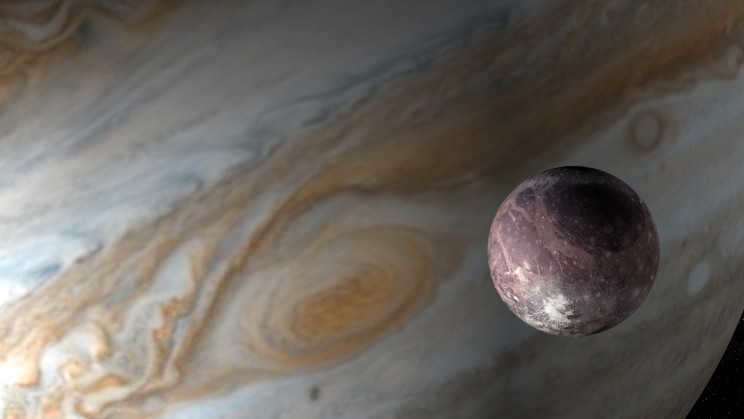
Jupiter and Ganymede.elanm35/iStock
In the final weeks of 2021, Scott Bolton, the leading expert on the Juno spacecraft, released a short audio recording taken by NASA’s probe while it was passing by Ganymede. Although the sound resembled the old dial-up internet connection, certain news sources referred to Ganymede as the “singing moon of Jupiter.”
However, there are several fascinating facts that set Ganymede apart as a truly unique moon. Here are a few of them.
Listen to the audio recording of Juno’s flyby of Ganymede
Ganymede holds the title for being the largest moon in our entire solar system
Ganymede is an enormous natural satellite situated approximately 665,000 miles (over a million kilometers) away from its parent planet, Jupiter. It completes a full orbit around Jupiter every seven days and three hours.
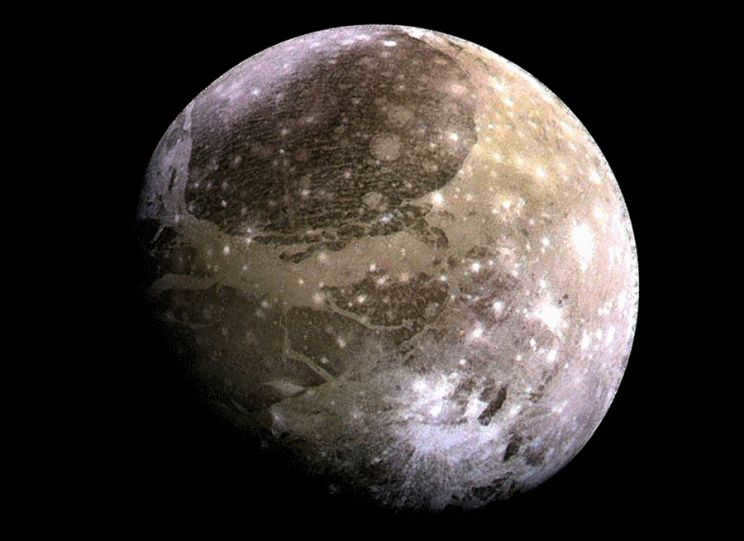
Source: Pablo Carlos Budassi/Wikimedia Commons
advertisement
Ganymede, with a radius of 1,635 miles (or 2,631 kilometers), holds the distinction of being the largest moon in our solar system. It surpasses Earth’s moon, which has a radius of merely 1,079.6 miles (1,737.4 kilometers), as well as Mercury, the smallest planet in our solar system, which has a radius of 1,516 miles (or 2,439.7 km), and Pluto, and is only slightly smaller than Mars. In fact, when ranking Solar System objects by size, Ganymede would secure the 9th position.
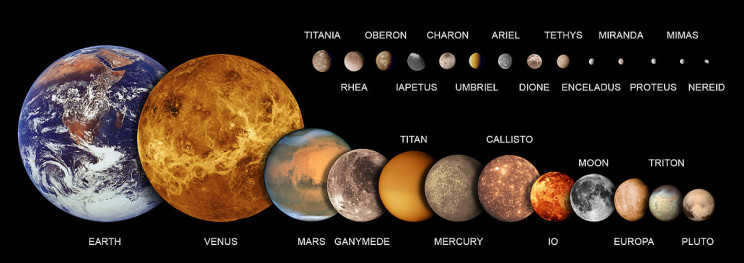
Source: Primefac/Wikimedia Commons
Ganymede, a moon of Jupiter, possesses a mass of 1.48×1020 tons, which is equivalent to twice the mass of Earth’s moon.
Ganymede was initially observed by Galileo Galilei.
Ganymede is one of the four moons of Jupiter that were first detected in the 17th century by the Italian astronomer Galileo Galilei. Hence, it is part of the quartet known as the Galilean satellites (Io, Europa, and Calisto). Three of these satellites were identified on January 7, 1610, as Galileo peered through his 20-power telescope. The fourth was spotted several days later.
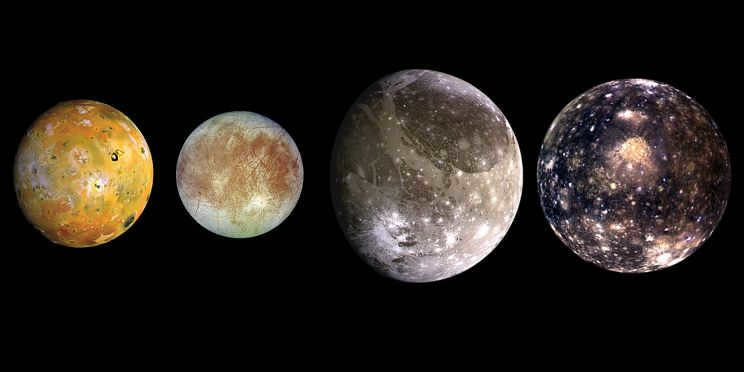
From left to right: Io, Europa, Ganymede, and Calisto. Source: Wiki Images/Pixabay
Initially, Galileo mistook them for celestial bodies. However, upon observing them through a telescope over a period of several days, he came to the realization that they were actually in motion around Jupiter. This was evident from their distinct movement in a different direction compared to the background stars, as well as their changing positions relative to each other while remaining close to the planet. Galileo quickly deduced that these were not stars, but rather satellites of Jupiter. In honor of his patron, the Grand Duke of Tuscany, Cosimo II Medici, he named them the “Medicean stars” or “Medicean satellites”.
Advertisement
To differentiate them, Galileo initially assigned numbers to the moons of Jupiter: Jupiter I, Jupiter II, Jupiter III, and Jupiter IV, based on their proximity to the planet. Ganymede was referred to as “Jupiter III.”

Back in 1630, Galileo Galilei made a significant contribution to the field of astronomy. The credit for the discovery of Jupiter’s satellites, however, was initially given to German astronomer Simon Marius. Even though Marius claimed to have found the satellites on January 8, 1610, his observations were not published until later, causing him to miss out on the recognition. It was only a few years later, in his Mundus Iovialis (1614), that Marius suggested the names Io, Europa, Ganymede, and Callisto for these satellites, drawing inspiration from Greek mythology. Interestingly, he credits Johannes Kepler for this idea.
It is worth noting that three centuries later, a panel of Dutch experts concluded that Marius had actually independently discovered Jupiter’s moons just one day after Galileo recorded his observations. This finding sheds new light on the history of these discoveries and the contributions made by both Galileo and Marius.
There is a significant amount of water present on Ganymede
advertisement
Ganymede primarily consists of silicate rocks and water ice. The stony material is situated above the metallic iron core and forms unique clusters beneath the ice shell. There is a belief that liquid water exists below the ice shell, and it is combined with a salt known as magnesium sulfate.
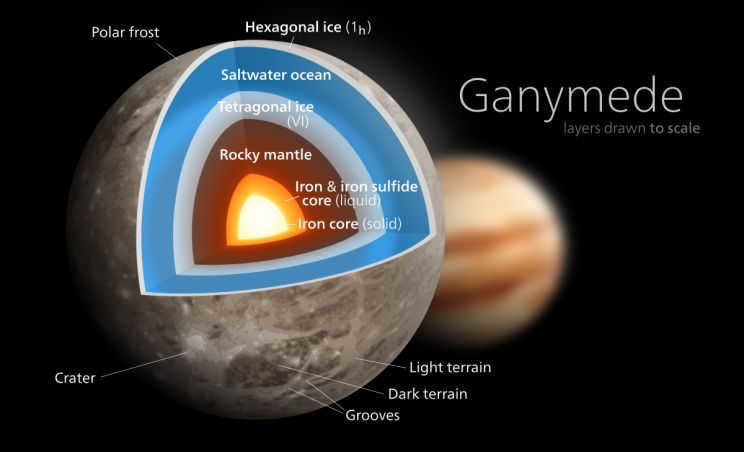
Source: Kelvinsong/Wikimedia Commons
The detection of this subterranean briny sea was initially made by the Galileo mission of NASA and subsequently confirmed by the Hubble Space Telescope’s data. Scientists posit that the subsurface ocean on Jupiter’s moon measures approximately 60 miles (100 kilometers) in depth, which is roughly ten times deeper than Earth’s oceans, and it harbors more water than all the reservoirs on our planet combined.
Additional evidence of water on Ganymede was discovered in 2021. It was during this time that NASA’s Hubble Space Telescope collected data confirming the presence of water vapor while studying the moon’s magnetic field. The scientists noticed variations in the magnetic field that they initially attributed to the existence of molecular oxygen in the moon’s atmosphere. However, further investigation revealed that these changes were actually caused by the sublimation of ice, which occurred as a result of the thermal emission of water vapor when icy regions warmed up.
Sublimation is a chemical process in which a solid material transitions directly from a solid phase to a gaseous phase. In the case of Ganymede, this process is thought to be triggered by temperature fluctuations near the moon’s equator.
Ganymede, one of Jupiter’s moons, has been discovered to contain water vapor, thanks to the findings of the Hubble telescope.
Ganymede experiences extreme temperatures, ranging from -297ºF to -171ºF (-182ºC to -112ºC). This is due to its distance from the Sun and its lack of a thick atmosphere to retain any heat from the limited sunlight it receives. However, data suggests that certain regions and specific hours of daylight on Ganymede can be significantly warmer.
Ganymede possesses a unique characteristic among all the moons in the solar system – it has its very own magnetosphere.
Among the planets in our solar system, only a select few are known to have magnetospheres – Earth, Saturn, Mercury, and Jupiter. However, in 1996, NASA’s Galileo spacecraft made a groundbreaking discovery when it recorded strange sounds, like whistling and buzzing, originating from Ganymede. These peculiar sounds were an indication of Ganymede having an independent magnetosphere. This finding suggests the presence of an active internal “dynamo” within Ganymede, most likely a liquid core abundant in iron and nickel, extending 250 to 800 miles (400 to 1,300 kilometers) beneath its surface. The convection of liquid iron, which exhibits high electrical conductivity, generates a magnetic field.
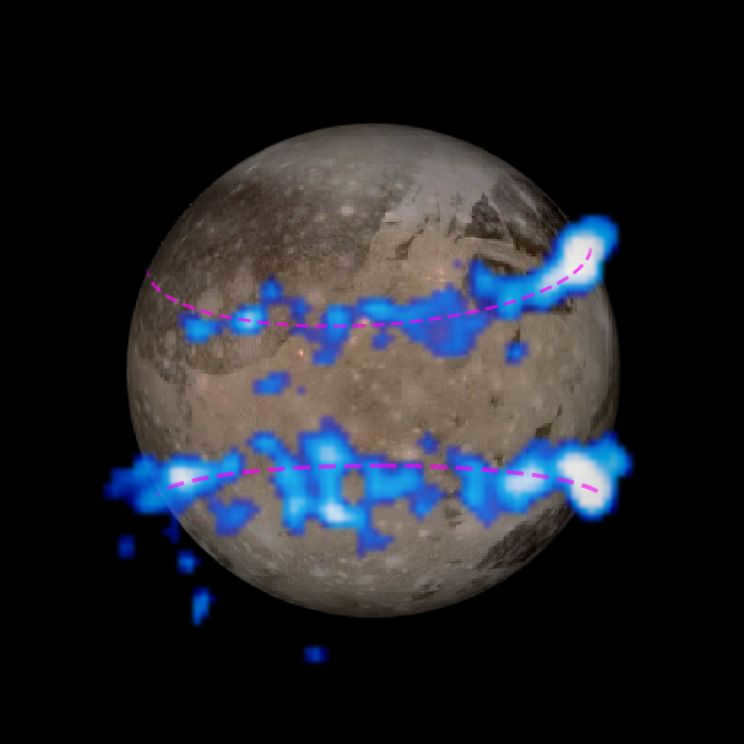
An image captured by NASA’s Hubble Space Telescope shows the auroral belts of Ganymede. Source: NASA/ESA
Similar to Earth’s magnetic field, Ganymede’s magnetosphere consists of charged particles that act as a protective barrier against cosmic radiation, including radiation from Jupiter. This magnetic field also generates beautiful auroras at the planet’s north and south poles, just like on Earth.
The glowing auroral belts, composed of electrified gases, were initially observed in ultraviolet images of Ganymede taken by the Galileo Plasma Wave Spectrometer and later by the Hubble Space Telescope Imaging Spectrograph.
According to NASA, Ganymede’s internal structures have been modeled by a computer, revealing that the interaction between salt water and rocky materials could potentially support primitive life on the moon. However, for life to thrive, it would have to exist beneath a thick layer of ice, beyond the reach of sunlight. This means that any organisms would need to possess the ability to survive without relying on the Sun’s energy, and instead have an alternate source of sustenance, similar to the deep-sea creatures found on Earth. Additionally, these hypothetical Ganymede inhabitants would have to withstand extreme pressures, surpassing those found in Earth’s well-known Mariana Trench, which reaches a depth of 11,034 meters.

